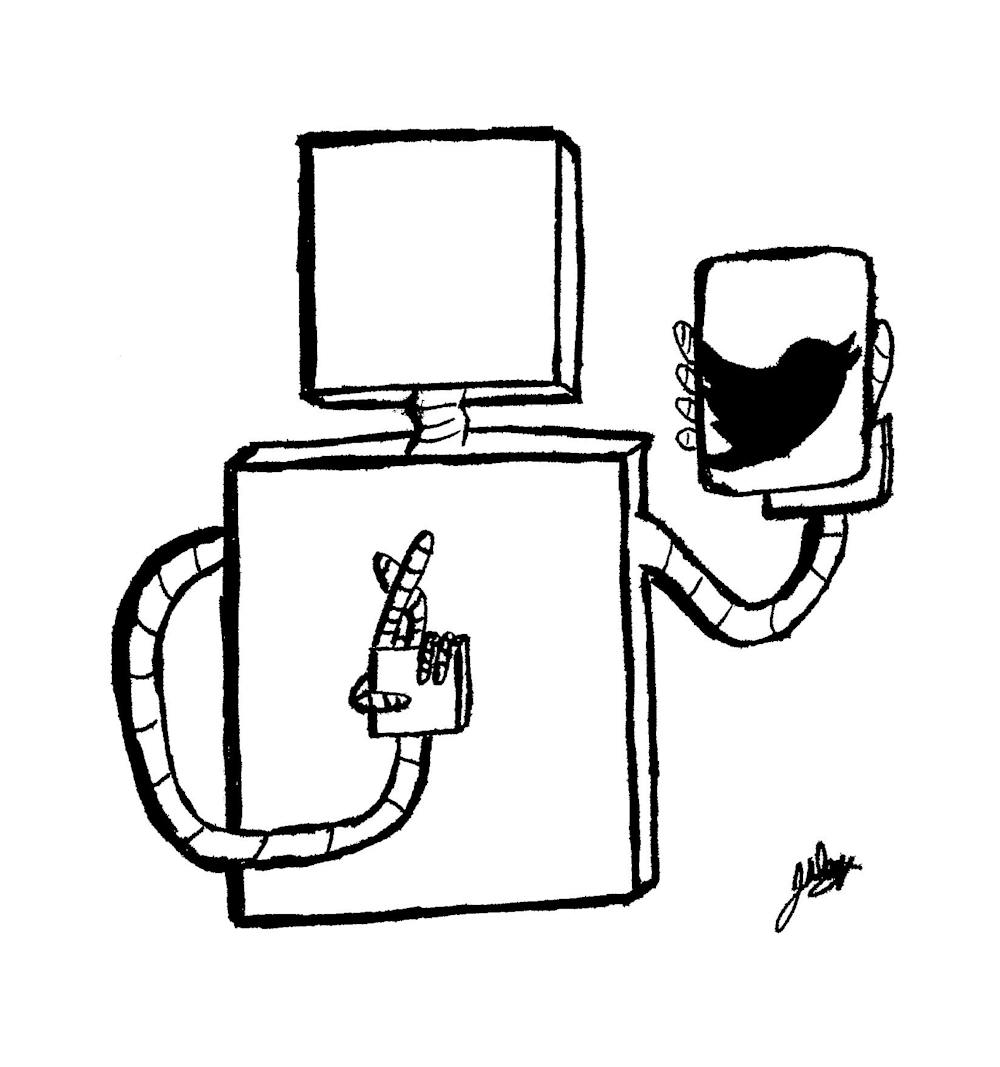I’ve been active on Twitter since 2014, and it is exhausting. On the one hand, I’ve derived some very real benefits — I discovered some of my favorite artists and creators, refined my political and personal perspectives, goofed around in direct messages with my friends.
But on the other, the sheer amount of content that passes before my eyes every time I open the app gets to be overwhelming. It starts to feel crowded, with hundreds of takes rattling around in my head and hundreds of very human personalities flooding my timeline. All the while, I know that there is something particularly unhealthy about the parasocial relationships Twitter fosters, but I am unable to look away.
Social media usage has intensified during the pandemic, probably out of a need for escapism. This is a bit counterintuitive, because it doesn’t feel so much like an escape anymore — or rather, it feels like a whole lot of people trying very deliberately to escape but continually turning to despair.
It is a heavy emotional burden to log in every morning and see a combination of pleas for financial assistance, fully justified anger at the state of the world, and cabin-fever-motivated bickering between niche internet communities that describe themselves as “irony-poisoned” or “brain-rotted” from too much time spent online.
And yet, I feel glued to the screen. It’s comforting to recognize when you’re not the only one having a hard time, and a feeling of dedication to the community with which you are commiserating can easily emerge — we’re in this together, right?
But how do I maintain this feeling of comfort when some pundit I’ve never heard of before says something completely bonkers, and I have to see every single reaction in real time immediately? I’m reminded of @maplecocaine’s oft-cited tweet: “Each day on twitter there is one main character. The goal is to never be it.” Well, what better way to avoid seeing all the main characters than to eliminate all humans from the timeline?
The term “Twitter bot” is, I think, commonly understood to refer to malicious, automated spammers: in a lot of recent discourse, the term “bots” often refers to accounts that repeatedly promote scams or attempt to disguise themselves as humans to increase clicks to a website. But in basic terms, bots are simply programs that have been coded to fulfill particular tasks, and there’s a large sector of benevolent bots.
These bots are undisguised programming projects that make their own tweets on a variety of creative themes. Many are made with platforms such as “Cheap Bots, Done Quick!”, which are fairly accessible even for people without extensive coding backgrounds.

The first bot I ever followed was @tinydotblot, programmed by the writer and illustrator Jonny Sun. Its bio describes the bot as “a small exercise in creative seeing” that sends out “a unique, automatically-generated dot-blot four times a day!” The account’s tweets, arrangements of dots which sometimes look like ships from Galaga or beetles or bowties, take up much more vertical space than your average wordy tweet. They visually divide up the timeline, providing both a brief respite from the surrounding discourse and a little puzzle — the replies are filled with guesses, such as “Two elephants cautiously attempt to kiss” and “The sharks from Katy Perry’s halftime show, back to back, looking up at the stars.”
After @tinydotblot, I discovered a few other bots, such as @PepitoTheCat, which tweets a picture of a sleek black cat every time he enters or exits his home through a door rigged up to a camera, and @MagicRealismBot, which, every four hours, tweets a randomly generated story, such as “A Catalan math teacher goes for a walk in a forest and discovers a yew tree made of light.” I also discovered a few lyric bots, such as @tmbotg, which tweets “random chunks” from songs by They Might Be Giants and quote bots, such as @dimension20bot, which tweets highlights from the webseries Dimension 20.
But recently, fed up with the density of my timeline, I thought, “why not go all the way?” I made a side account that only follows bots — 35 of them — to see how it would feel to check a version of Twitter not populated by a single human. I chose bots in the style of @tinydotblot, such as @tiny_star_field and @EmojiMeadow; more quote and lyric bots from assorted media properties; image bots such as @RibbonDiagrams, which tweets random protein structures, and @MoMARobot, which shares objects from the Museum of Modern Art; and a variety of oddities such as @infinite_scream (“AAAH” in different lengths), @DeathMedieval (“real deaths from medieval coroners’ rolls”), @everyword (every single word in English in alphabetical order), and @tinycarebot (self-care reminders every hour).
This Bot-World was soothing, at first. No pressure to interact, no high-octane arguments. It felt almost like sitting in a quiet room by myself. I was able to focus more on the content the bots were creating, instead of scrolling past and barely reading them on my way to juicier tweets. With a fully automated version of Twitter, there is a lot less stress about “catching up” or “scrolling back” to make sure I have seen everything — if I don’t catch a few randomly generated proteins, no big deal. There’s a much stronger fear of missing out when the thing I might not see is the outrageously bad take that everyone is talking about.

Bot-World, however, isn’t a perfect solution to isolate the best of Twitter without its many faults. It can get repetitive — some bots were trained on a limited set of values, so they regularly cycle back through the same tweets. And since computer programs don’t spend several hours a day asleep, the stream of new posts is pretty much non-stop. It can also get a bit lonely.
Sure, there’s less social pressure to engage without real people on the other end, but for all the good that being in a quiet room by myself can do me, I’ll eventually want to go back outside. The bots, even with their many features, can’t message me tweets they think will crack me up, or introduce me to their favorite musicians, or offer astute commentary on issues I had never considered before.
Twitter is designed to keep you online. It’s designed with the purpose of flooding your mind with so much content that you never want to delete your account. Even an all-bot timeline is still interrupted every few tweets by promoted ads, and a sidebar constantly tracks live news updates. The algorithm will display the activity of accounts you follow, not just their actual tweets — we get fed other people’s likes, their replies, their followers’ replies, and even tweets from the people they follow.
You’re supposed to keep clicking the shiny buttons even when you’re sick of it. Eliminating human input from my experience doesn’t make it a haven — in fact, it makes the tools Twitter uses to pump up engagement even more obvious; they stand out so starkly in comparison to the predictable simplicity of bot tweets.
I’m also reminded that it’s a vast privilege to check out entirely. I get so much of my news and analysis from Twitter, so tuning out of the material struggles happening every single day doesn’t feel like the right thing to do. I don’t think I should opt out of being informed and, in doing so, treat engagement with human rights as optional and transient and someone else’s problem.
So I slunk back to my main account. Maybe there’s a better solution to separating the advantages of sites such as Twitter from their constant haggling over our clicks, but, especially while I’m in isolation from my real-world social networks, that doesn’t feel like an immediate possibility. For now, I’ll continue to follow some of my favorite bots as well as some of my favorite humans.
And anyways, I think it’s healthier to engage with Twitter as a quick study break a few times a day rather than a constant beam into my brain. Changing who I follow didn’t help much with the addictive nature of social media — but changing how I check in with those accounts might.








